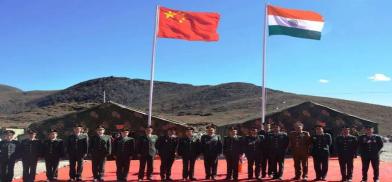Another round of India-China military talks : Obfuscating ground realities?
The latest round of military-to-military talks was orchestrated to time with Prime Minister Narendra Modi attending the BRICS Summit in South Africa on August 22-24 and the G20 Summit in New Delhi on September 9-10, which Chinese President Xi Jinping is slated to attend.

The 19th round of Corps Commander-level India-China talks was held at the Chushul-Moldo meeting point in eastern Ladakh from 9.30 am to 5.30 pm on August 14, 2023. The Indian side reportedly pushed for disengaging from more “friction points” (euphemism for intrusions). At best the Chinese side would have demanded more buffer zones, if at all. A statement in the usual diplomatic jargon may be issued in a day or two.
The 18th round of military-to-military talks, held on April 23, 2023, were without any progress, as expected. China has consistently signaled since the last few rounds that it will not disengage anymore, especially in areas of Depsang Plains and Demchok. At one stage, China even asked for a 15-20 km buffer zone in the area of Depsang. India keeps asking for more talks which are used by the Chinese People's Liberation Army (PLA) to consolidate its newly occupied positions from 2020.
China continues to speedily develop border infrastructure along the entire length of the Line of Actual Control (LAC) from Ladakh to Arunachal Pradesh. In Ladakh, the PLA has consolidated positions in terms of bunkers, fortifications, posts, observation towers, artillery positions, SAM systems, radar stations, ammunition storage and new helipads. There is massive infrastructure development in the stretch between Finger 8 and Chinese military bases to the east at Sirijap-I and II on the north bank of Pangong Tso.
The PLA will soon complete the main bridge on Pangong Tso for the movement of mechanized columns, after building the secondary one last year, for faster mobility between the north and south banks of the lake. PLA has increased the number of troop shelters, weapon systems, jetties and assault boats near the no-patrol buffer zone established along the north bank of Pangong Tso post disengagement in February 2021. China has also positioned tanks at Finger 8 from where a metal road runs west along the north bank to the solitary Indian post on the north bank.
India remains at military disadvantage
Similar PLA activities are ongoing in the Middle Sector (Himachal Pradesh and Uttarakhand) as well as in the east opposite Sikkim and Arunachal Pradesh. PLA activity has increased in terms of vehicles, patrols, infrastructure development and construction of dual-use military villages opposite Barahoti in Uttarakhand and in the vicinity of Lipulekh in the middle sector. In the east, hectic PLA activity is underway with area clearance and earth-moving equipment in several areas opposite Siang, Kameng and other parts of Arunachal Pradesh. All this indicates that the PLA will continue with its forward deployment along the entire LAC.
With India’s Ministry of External Affairs (MEA), in-charge of settling the border with China, diplomats keep asking for more rounds of military-to-military talks to obfuscate the fact that China has taken us for a ride. The only so-called progress in 19 rounds of talks is creation of buffer/no-patrol zones along the north bank of Pangong Tso, in the area of Galwan, and Hot Springs. All these buffer zones are inside Indian territory. The government is loathe to acknowledge loss of control of some 1,000 sq km of territory to China.
Moreover, India vacated the Kailash Range in its own territory overlooking the PLA garrison at Moldo, only to showcase PLA move from Finger 4 to Finger 8 along the north bank of Pangong Tso in full media glare, although we continue to remain at a disadvantage. To add to this folly, withdrawal from Kailash Range in our own territory was not linked to PLA withdrawal from Depsang and Demchok; recouping from this strategic lapse is well nigh impossible because China holds all the aces..
The 19th round of talks, on the eve of India’s 77th Independence Day, was perhaps to show that India means business with China although we have not labeled China the “aggressor” even once in the last three years.
Diplomatic gullibility and political expediency
It is amusing to note recent media headlines that India airlifted 26,000 troops to Ladakh after the Galwan skirmish – an event that happened three years ago. Some say this is sweetener for the Indian Air Force after the prime minister denigrated them in his recent speech in Parliament for having bombed Aizwal in Mizoram in 1966. Others say this is diverting from the fact that India virtually “invited” the PLA by denying army formations moving to Ladakh for annual maneuvers with the lockout restricting rail move in 2020.
The latest round of military-to-military talks were orchestrated to time with Prime Minister Narendra Modi attending the BRICS Summit in South Africa on August 22-24 and the G20 Summit at New Delhi on September 9-10, which Chinese President Xi Jinping is slated to attend in person. But Xi Jinping appears pretty certain what he wants despite the talk of China in decline, Xi facing insurmountable problems at home, the BRI failing and all that. The presence of three former service chiefs from India attending the Ketagalan Forum in Taiwan wouldn’t bother Xi anyway.
According to a Member of Parliament, China distributed maps showing Arunachal Pradesh and Ladakh as part of China and Jammu &Kashmir as part of Pakistan during the SCO Summit in Uzbekistan in September 2022, attended by Xi and Modi. Can we dub this only Beijing’s information warfare? China has announced the G-695 expressway running close to Galwan and Hot Springs, which is to be completed by 2035.
Given our diplomatic gullibility and political expediency to obfuscate ground realities, India can be expected to continue asking for more military-to-military talks with China.
(The author is an Indian Army veteran. Views expressed are personal.)










Post a Comment